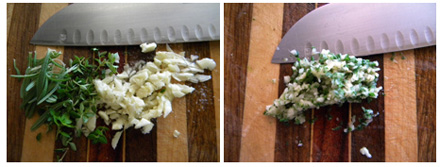mostarda di frutta and rack of lamb
Mostarda and Lamb’s main ingredients
Mostarda di Frutta is an Italian condiment made of candied fruit in a mustard-flavored syrup. It is served with boiled, roasted, or grilled meats, and is a fabulous accompaniment to cheeses.
The rack of lamb is “Frenched” which means the meat, fat, and membranes that connect the individual rib bones are scraped or trimmed away from the end of the bone down to about two inches above the rib-eye area. This is generally done on lamb chops, veal rib chops, or a crown pork roast. Frenched racks and chops can be purchased already done or you can “French” them on your own at home. Click this link for a great video demonstration from Fine Cooking on how to French a rack of lamb. If you do decide to French the lamb yourself, discard the fat and membrane, but be sure to save all meat scraps and use them as stew meat or grind to make into lamb burgers.
Wild rice is not true rice or a grain, but grass native to the Great Lakes region of North America. It is gluten-free and is a good source of potassium, phosphorus, thiamine, and riboflavin. Wild rice needs much more water and cooking time than white or brown rice; the water ratio is about 4 to 1. It takes about an hour to cook and not all the water is absorbed, the excess is drained away. Because of the long cooking time, I generally make a double batch and use half of it for another meal. Another common way to serve wild rice is to mix it with brown rice; this half-and-half combination makes it tasty and budget-friendly since wild rice is more expensive than other types of rice.

garlic, herbs, and salt before – and after mincing into a paste
There is a garlic-herb paste rubbed on the lamb and topping the tomatoes. A little bit of kosher salt is used in the mix, its purpose is to help break down the garlic, it makes a big difference in the texture of this paste and is always a great technique to use the next time you make aioli too.
[Read more →]
November 2, 2009 1 Comment

